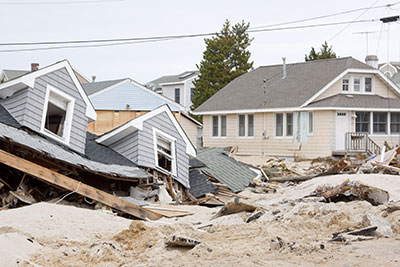How to Prepare Your Home for a Cyclone
March 5th, 2015

Cyclones are categorised as strong, destructive winds that spin around a calm centre. Every year in Australia, homes suffer from thousands of dollars’ worth of damage – caused mainly due to overlooked maintenance. The amount of damage your home suffers can be reduced by performing a few simple tasks to ensure your house is sturdy and prepared for extreme weather.
If you live in an area that is in the high risk category for cyclones, you will understand the importance of making sure you are prepared. There are a few things you can do to help defend your home from the destructive winds of cyclone season and have you prepared for any weather.
Make an emergency plan
Most importantly, make sure that you and your family develop an emergency plan, and that everyone knows exactly what to do when a cyclone approaches. Keep this emergency plan somewhere accessible, like on the fridge, and be sure to revise it with your family members during cyclone season.
Inspect the exterior of your home
Regularly inspect the exterior of your home for signs of deterioration or weakness. Be sure that any rusty brackets, fasteners, or clamps are replaced immediately. Inspect all wooden areas, including facial boards, decks, verandahs, and structural beams. Rotten wood weakens structure and also needs to be replaced immediately.
Check your roof
If you have a tin roof, check to make sure that screws are firmly fastened and free of rust. Rust can allow the weather to get inside during fierce storms, or for the roof sheeting to become loose. If your roof is tiled, replace any cracked pieces and make sure all tiles are safely fastened. Don’t forget to check the eaves!
Check your garden
Ensure that all tree branches are cut away from the house. It is preferable to not have trees near the house whatsoever, as they’re always in danger of falling. Limit the amounts of ornaments in your yard. Everything loose and unfastened becomes a projectile during a cyclone, so the less you have around your house, the better.
Make sure that all loose objects are put away after use. This saves time when the weather changes unexpectedly. Children’s play equipment, like swing sets and trampolines, should be properly attached to the ground with fasteners during the installation process.
Be prepared
You should always be prepared for two scenarios – one in which you are isolated for days, and one in which you may have to evacuate the home. Pack a bag that includes two sets of clothes for every person in the home – pyjamas, underwear, and basic necessities – and keep this ready to go. Pack a separate bag that contains emergency contacts, a copy of the evacuation plan, medications, first aid items, and personal hygiene items that can be easily accessed if needed.
Pack an emergency kit
Be sure to prepare yourself in the event that you get isolated due to floodwaters or storm damage. Make sure you have enough non-perishable food items to last your family at least 5-7 days, and prepare a separate kit to take if you leave the home. This kit should contain a battery operated radio, battery operated phone chargers, flashlights, a lot of spare batteries, candles, matches, and a lighter (yes, pack both!)
Invest in a cyclone screen
Just because you live in an area at risk of cyclones, it doesn’t mean you should sacrifice appearance for safety features. At SecureView, we haveCyclone-grade mesh screens that are both stylish and functional. These screens can withstand up to 4kg of wood, travelling up to speeds of 390km/hr, and are guaranteed to increase the safety levels of your home.
If you’re still unsure about how safe your home might be in the event of a cyclone, employ the services of a professional builder who can assess your home and offer advice on where to improve. Another handy tip is to ensure you have maximum coverage on your home and contents insurance. Many insurance companies offer discounts for homes that are fitted with safety screens that meet Australian standards.
